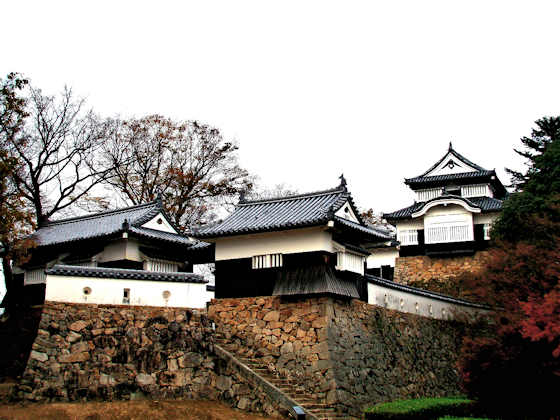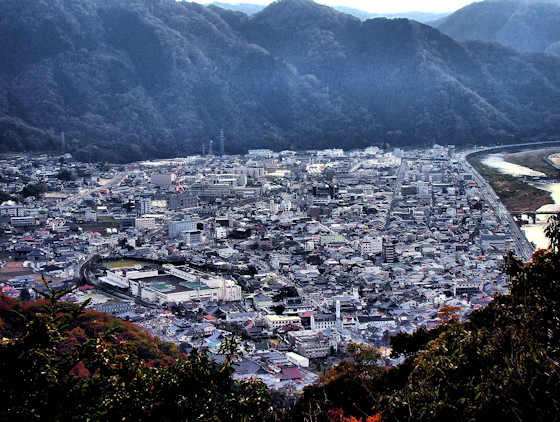Wednesday, February 10, 2010
The view from the highest castle in Japan
Getting up to Bitchu Matsuyama castle, Japan's highest, is not very easy. There is no public transport up the steep road, though you can drive or take a taxi three quarters of the way up, there is still a steep climb to the top. From the bottom allow a good hour to walk up.
The view down to Takahashi, about 1,000 feet below is worth the climb though.
Takahashi and its castle doesn't get a lot of visitors as its not on the Shinkansen, but its worth a visit.
As well as the castle there are a lot of Edo-period buildings in one section of town and a wonderful zen garden. Nearby is a wonderful Tadao Ando building housing a large art museum. There's lots of signs in English.
The rest of Takahashi is a a fairly typical "cookie cutter" Japanese town.
Its located on the JR Hakubi line which connect Okayama City with Yonago, Matsue and Izumo.
Tuesday, February 9, 2010
The highest castle in Japan
Labels:
bitchu matsuyama,
castle,
okayama,
takahashi
Monday, February 8, 2010
Red hats & bibs: cliffside
Buddhist statues wearing red hats and bibs can be found all over Japan. In wayside shrines and altars there will be alone or in small groups. In larger temples there may be many of them in lines.
In Tachikue Gorge on the Kando River a few k south of Izumo City, there are hundreds of them arrayed along a cliff for about 500 meters.
There are 1,000 statues of various buddhas, and 500 statues of Buddhas disciples.
This area was a centre for Yamabushi until Shugendo was outlawed in early Meiji.
Buses from Izumo Station stop along the gorge.
Saturday, February 6, 2010
Concrete Wabi Sabi: Virgin tetrapods
Concrete Wabi Sabi: Virgin tetrapods
I like this photo because without any scale reference, one could be looking at something architectural, a stadium maybe.But in fact, it's just a line of new tetrapods waiting to go in place to "protect" the riverbank.
New concrete can have an aesthetic quality, in my opinion.
There are tetrapod production sites all over the place. Mostly they are made in situ, you just need the molds and a constant stream of cement trucks.
I haven't been able to find the numbers, but I'm willing to bet that Japan leads the world in the number of cement trucks per capita.
Friday, February 5, 2010
Japan from the air.
Flying back into Japan on Wednesday I was able to get a few decent shots. This first one is somewhere in north Kyushu.
Kyushu has a lot of active volcanoes, and I've studied maps to try and find which one this is, but couldn't be sure. If anyone knows, please let me know.
Kochi City on the south coast of Shikoku.
Somewhere in eastern Shikoku.
In the middle of Awajima, descending to land at Kansai Airport.
Thursday, February 4, 2010
The biggest shimenawa in the world
The biggest shimenawa in Japan, and therefore the world, is located up in Izumo at the great shrine of Izumo Taisha.
It adorns the Kagura den, located next door to the shrine proper.
It's more than 13 meters in length and weighs somewhere between 5 and 8 tons.
A new one is constructed every 3 years.
Labels:
Izumo,
Izumo Taisha,
shimenawa,
shinto
Monday, January 25, 2010
Hungry Koi
Koi is the Japanese name for Carp. They were introduced from China about 500 years ago primarily as a food source.
Around 1820 they began to breed them for color variations and there are now dozens of distinct varieties.
A few years back our river flooded and when the waters receded some koi were left stranded in the rice paddies so our neighbor gave us one to eat, but it is not a pleasant flavor.
Labels:
koi
Saturday, January 23, 2010
The seven bridges of Daiwa.
Daiwa Town is a collection of villages along the middle reaches of the Gonokawa River. With the recent spate of consolidations it is now considered part of Misato-cho.
It's a pretty area, and other than a couple of onsens there are no tourist attractions. We go up there sometimes to visit a potter friend whose work can be seen here.
Seven bridges cross the Gonokawa within the town boundary, and these bridges form the design for the towns manhole covers.
Here are some photos of just a couple of them.
Labels:
bridge,
drainspotting,
Gonokawa,
Iwami,
manhole
Friday, January 22, 2010
What big ears you have!
Pairs of fox (kitsune) statues are common throughout Japan, as they are the guardians of Inari shrines. There is a massive diversity of styles and designs, and I have seen some pretty strange ones, but never any with ears like this!
They are at a small Inari shrine within the grounds of a temple in Takahashi, Okayama.
Thursday, January 21, 2010
Kitakyushu International Conference Center
The Kitakyushu International Conference Center is located in the old port area a 10 minute walk from Kokura train station.
It was opened in 1990 and was designed by Arata Isozaki.
Isozaki was born not far from Kokura in Oita, and at 78 years old is the current grand master of Japanese architecture with prestigous building all over the world.
This is not one of his better known buildings, but I found interesting enough with its combination of curves and angles.
Labels:
Arata Isozaki,
Architecture,
kokura,
kyushu
Subscribe to:
Posts (Atom)


















